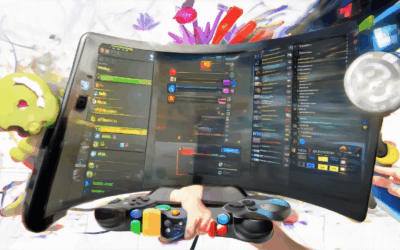Exploring Game Control Mechanics: A Deep Dive into the Core Elements and Gameplay Features
Gaming has come a long way since its inception, evolving from simple pixelated graphics to complex worlds filled with intricate mechanics. At the heart of every successful game lies the concept of game control mechanics, the systems that dictate how players interact with the virtual environment. Whether it’s mastering the physics of jumping in a platformer or navigating the strategic layers of a real-time strategy game, control mechanics form the foundation of immersive gameplay.
From classic titles to modern masterpieces, the evolution of game mechanics has been driven by developers pushing boundaries and redefining player expectations. This article delves into the core elements of game mechanics, exploring how they shape experiences and influence design choices. We’ll examine the fundamental principles that make games engaging, the innovative control schemes that set new standards, and the future trends that promise to revolutionize gameplay forever.
Whether you’re a casual gamer curious about the technical aspects of your favorite titles or a developer eager to understand the mechanics behind successful games, this exploration will provide valuable insights. By breaking down the components that make games tick, we’ll reveal how control mechanics contribute to fun, strategy, and emotional connection. So, let’s embark on this journey through the world of game mechanics and uncover the secrets behind the systems that keep us hooked.
- Understanding the Basics of Game Mechanics
- What Are the 4 Elements of Game Mechanics?
- The Evolution of Game Mechanics Over Time
- Exploring Game Control Mechanics
- How Do You Explain the Game Control?
- The Role of Controls in Enhancing Player Experience
- Core Mechanics of Popular Games
- What Are the Basic Mechanics of a Game?
- Case Studies: Analyzing Mechanics in Successful Titles
- Game Mode Rules and Functionality
- What Are the Rules for Control Game Mode?
- Customizing Game Modes for Personalized Play
- Advanced Features in Game Control
- Can You Fly in the Game Control?
- Innovative Control Mechanisms in Modern Games
- The Purpose Behind Game Control Systems
- What Is the Point of the Game Control?
- Balancing Fun and Strategy Through Control Design
- Future Trends in Game Mechanics
- Predicting the Next Evolution in Game Mechanics
- Integrating AI and Machine Learning in Game Mechanics

The Four Elements of Game Mechanics
Game mechanics are the foundational components that define how players interact with and experience a game. Below, we break down the four primary elements of game mechanics:
- Quantity : This element deals with the number of items, units, or resources available in the game. Examples include coins, health points, or collectibles.
- Spatial : This refers to the physical arrangement of objects in a three-dimensional space. Examples include platforms, obstacles, or enemies in a game like Mario.
- State : This element represents the current condition or status of objects, characters, or the game itself. Examples include health bars, weapon states, or game modes.
- Action : This involves the actions players can take to influence the game world. Examples include jumping, attacking, or solving puzzles.
These mechanics work together to create a cohesive and engaging experience, allowing players to interact with the game in meaningful ways. By understanding and applying these principles, developers can design more effective and enjoyable games.
Exploring the Game Control
Control is an action-packed video game developed by the talented team at 343 Industries . Released in 2019 for the Xbox One and later ported to PC, Control quickly gained acclaim for its unique gameplay mechanics and immersive storytelling.
Gameplay Mechanics
The core of Control lies in its dynamic gameplay. Players utilize a combination of telekinetic abilities and a versatile weapon called the “Shifter” to navigate and combat enemies. Movement is crucial, as staying stationary for too long can lead to overwhelming by enemies. Speed and precision are key to survival, making every second count in intense firefights.
Key Features of the Game
- Telekinetic Powers: Players can manipulate the environment, launch objects, and control enemies using their telekinetic abilities, adding a strategic layer to combat.
- Shifter Weapon: The Shifter is a multi-functional tool that adapts to various combat scenarios, allowing players to switch between forms to tackle different challenges effectively.
- Dynamic Environments: The game’s world is interactive, with destructible environments and hidden paths that reward exploration and creativity in problem-solving.
- Intense Combat: Control emphasizes fast-paced, tactical combat where timing, positioning, and using the environment to your advantage are essential to overcoming enemies.
Story and Setting
Set in the fictional city of New York City , Control’s narrative revolves around a secret organization known as the Foundation , which seeks to control powerful telekinetic entities called Shapers . The protagonist, Jessica , is a young woman who uncovers the truth about her abilities and the world she inhabits. The game’s story is delivered through a mix of cutscenes, dialogue, and documents scattered throughout the environment, encouraging exploration and discovery.
Multiplayer Experience
While the primary focus is on the single-player campaign, Control also offers a multiplayer mode called Battlefront . This competitive mode allows players to engage in thrilling matches using the same Shifter and telekinetic abilities, providing a unique twist on team-based combat.
Why Play Control?
Control stands out in the gaming community for its innovative gameplay, stunning visuals, and a gripping narrative. Its blend of action, strategy, and exploration makes it a standout title in the action genre. Whether you’re a fan of shooters, puzzle games, or story-driven experiences, Control has something to offer for everyone.
Visit our website to learn more about indie game development resources and discover other exciting titles like Control!

What Are the Basic Mechanics of a Game?
The basic mechanics of a game refer to the foundational rules and elements that define how players interact with the game world and determine outcomes. These mechanics are crucial as they establish the framework for gameplay, objectives, and player engagement.
Core Components of Game Mechanics
- Gameplay Rules: These are the instructions that dictate how players can interact with the game. Examples include movement, combat, and item collection.
- Scoring System: A mechanism to track player performance, often tied to objectives like points, levels, or high scores.
- Progression System: A system that allows players to advance through the game, such as leveling up, unlocking abilities, or accessing new content.
- Ludemes: Unique gameplay concepts or elements that define the nature of the game, like specific moves (e.g., the knight’s L-shaped move in chess) or game modes.
How Game Mechanics Apply Across Different Genres
- In Action Games: Mechanics like quick reflexes, character upgrades, and enemy patterns dominate.
- In Strategy Games: Mechanics involve planning, resource management, and strategic decision-making.
- In RPGs: Mechanics include character classes, ability trees, and quest systems.
- In Fighting Games: Mechanics revolve around controls, combos, and fighting styles.
Conclusion
Game mechanics are the backbone of any gaming experience. By defining how players interact with the game and shaping the outcomes, they create a structured and engaging environment. Understanding and refining these mechanics is essential for creating a polished and enjoyable game.

Rules for Control Game Mode
The Control game mode in Call of Duty involves intense teamwork and strategic planning. Here are the key rules to master this mode:
- The game alternates between two teams, each controlling different objectives on the map.
- Teams switch between attacking and defending two separate objective points, typically labeled A and B.
- To secure an objective, the attacking team must complete all three segments of the control point:
- Each segment must be fully captured before moving on to the next, and once a segment is completed, it cannot be reversed by the opposing team.
- The defending team must prevent the attackers from completing all three segments to win the round.
- If all three segments are captured by the attackers, they win the round; otherwise, the defenders retain control.
Tips for Mastering Control Mode:
- Work together as a team to coordinate attacks and defend effectively.
- Focus on capturing one segment at a time to avoid losing progress.
- Utilize cover and stealth to avoid being caught off guard by the defending team.
- Stay aware of the defending team’s positions and communicate any threats immediately.
- Practice maps frequently to familiarize yourself with the layout and optimal attack/defense routes.
By following these rules and tips, you can dominate the Control game mode and become a formidable player.
Can You Fly in the Game Control?
Yes, you can fly in the game Control by utilizing the Levitate ability. Levitate is obtained during the main mission titled “My Brothers Keeper.” Once activated, this ability allows Jesse to float for a limited duration, depending on her ability level. However, using Levitate requires managing your energy pool carefully, as crashing or slamming into the ground will deplete your energy completely.
While Levitate offers a unique way to navigate environments, it’s important to note that its duration and effectiveness are influenced by your character’s skill level and playstyle. This ability adds a dynamic element to gameplay, encouraging strategic use of your abilities to overcome challenges.

What is the Point of the Game Control?
The game Control is a critically acclaimed indie title developed by the team behind the Amnesia series, Frictional Games. Released in 2015, the game immerses players in its eerie atmosphere and unique gameplay mechanics. Here’s a breakdown of the key elements:
- Gameplay Mechanics :
- Players assume the role of Jesse Faden, an employee of the fictional Federal Bureau of Control (FBC), who investigates strange occurrences in the Oldest House, the FBC’s paranormal headquarters.
- The game combines exploration, puzzle-solving, and combat. Jesse can manipulate the environment using a variety of abilities, such as freezing time, teleportation, and creating force fields.
-
The primary threat is the Hiss, a mysterious and dangerous entity that has infected the world, turning people into hosts for its consciousness.
-
Story and Setting :
- The narrative delves into themes of corruption, power, and the consequences of unchecked ambition.
- The Oldest House serves as the central hub, filled with cryptic puzzles, hidden histories, and unsettling discoveries.
-
The game’s world is rich with lore, drawing inspiration from real-world conspiracy theories and urban legends.
-
Unique Aspects :
- Unlike traditional shooters, Control emphasizes psychological horror and strategic thinking.
- The game’s combat system is based on timing, positioning, and using the environment to your advantage.
-
The ability to switch between first-person and third-person perspectives adds depth to the gameplay experience.
-
Reception and Legacy :
- Control received widespread praise for its innovative gameplay, atmospheric storytelling, and visual style.
- It was praised for its focus on storytelling over spectacle, offering a fresh take on the survival horror genre.
In conclusion, Control is a game that challenges players with its intelligent design, immersive world-building, and unique mechanics, making it a standout title in the indie gaming scene.




0 Comments